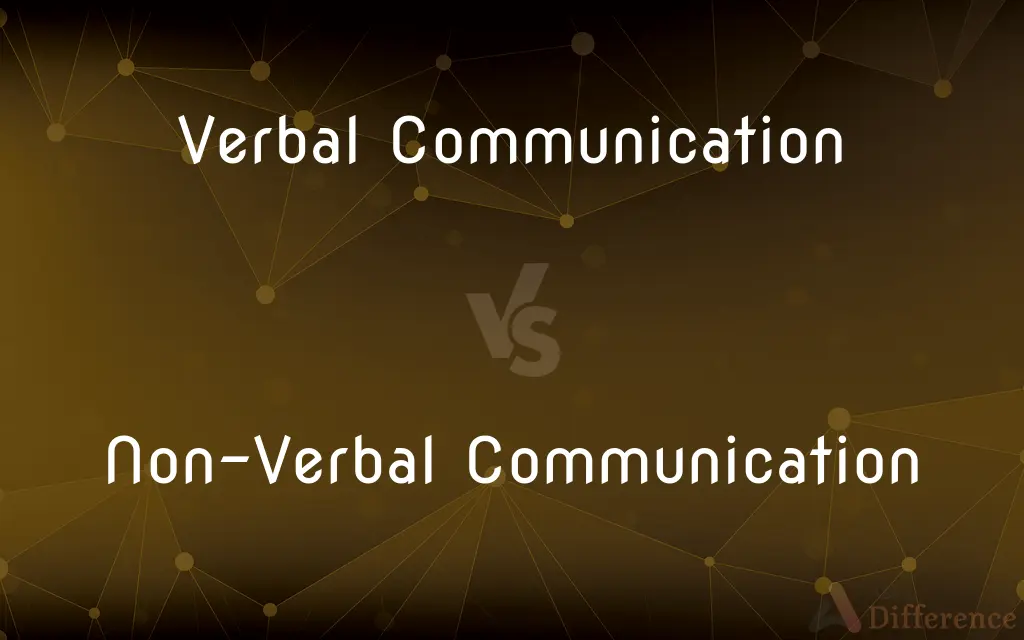Verbal Communication vs. Non-Verbal Communication — What's the Difference?
By Tayyaba Rehman — Published on January 26, 2024
Verbal Communication involves words, spoken or written, to convey messages. Non-Verbal Communication uses body language, facial expressions, tone, and gestures to communicate without words.

Difference Between Verbal Communication and Non-Verbal Communication
Table of Contents
ADVERTISEMENT
Key Differences
Verbal Communication refers to the use of words, both in spoken and written form, to exchange information and ideas. It is structured by language and is often direct and clear in conveying specific messages. Non-Verbal Communication, on the other hand, encompasses all forms of communication that do not use words, including body language, facial expressions, gestures, posture, and tone of voice. It often conveys emotional states and attitudes.
In Verbal Communication, the clarity of the message can be enhanced or diminished by the speaker's vocabulary, fluency, and clarity of speech. It's the primary mode of communication in formal settings. Non-Verbal Communication often complements or contradicts verbal messages and is crucial in conveying attitudes and emotions, sometimes communicating more powerfully than words.
Verbal Communication is essential in conveying complex concepts, instructions, and legal information, where precise language is necessary. It includes both oral and written forms, like conversations, speeches, emails, and reports. Non-Verbal Communication is often more subtle and can be open to interpretation, including elements like eye contact, touch, and spatial distance (proxemics).
The effectiveness of Verbal Communication often relies on the listener's understanding of the language used, making it potentially less effective across language barriers. Non-Verbal Communication can transcend language barriers to some extent, but cultural differences can affect interpretation.
Verbal Communication is essential in academic, professional, and informational contexts, where clarity and record are important. Non-Verbal Communication plays a significant role in social interactions, expressing empathy, and building relationships, where emotional connection is key.
ADVERTISEMENT
Comparison Chart
Medium
Words (spoken or written)
Body language, facial expressions, gestures
Clarity
Often direct and clear
Can be subtle and open to interpretation
Role
Conveys specific information and instructions
Expresses emotions and attitudes
Cultural and Language Dependence
Language-dependent, less effective across language barriers
Transcends language but influenced by cultural norms
Use in Contexts
Academic, professional, formal settings
Social interactions, emotional expressions
Compare with Definitions
Verbal Communication
Verbal Communication is the exchange of information using words.
Giving a speech is a form of verbal communication.
Non-Verbal Communication
Non-Verbal Communication involves body language to convey messages.
Nodding your head is a form of non-verbal communication indicating agreement.
Verbal Communication
Verbal Communication can convey complex and precise information.
Legal contracts are examples of verbal communication requiring precision.
Non-Verbal Communication
Facial expressions are a significant part of Non-Verbal Communication.
A smile can communicate friendliness without words.
Verbal Communication
Verbal Communication is structured by specific languages.
A debate is an instance of verbal communication using structured language.
Non-Verbal Communication
Gestures are a key element in Non-Verbal Communication.
Waving your hand is a non-verbal way to greet someone.
Verbal Communication
Verbal Communication includes both spoken and written forms.
Writing an email is an act of verbal communication.
Non-Verbal Communication
Non-Verbal Communication includes the use of spatial distance or proximity.
Standing close to someone can convey intimacy in non-verbal communication.
Verbal Communication
Verbal Communication is key in formal and academic contexts.
Lectures are a form of verbal communication in educational settings.
Non-Verbal Communication
Tone of voice is an aspect of Non-Verbal Communication.
A soft tone can convey empathy in non-verbal communication.
Common Curiosities
Why is Verbal Communication important in business?
It provides clarity and precision in conveying instructions, agreements, and information.
What is Verbal Communication?
It's the use of words, spoken or written, to exchange messages and information.
Can Verbal Communication be misunderstood?
Yes, especially if language is used ambiguously or the listener misinterprets the words.
How does culture affect Verbal Communication?
Cultural norms can influence language use, meaning, and understanding in communication.
How does Non-Verbal Communication differ across cultures?
Different cultures have varying interpretations and norms for non-verbal cues like gestures and eye contact.
In what situations is Verbal Communication preferred?
In formal, educational, and professional settings where clarity and record-keeping are important.
Is eye contact part of Non-Verbal Communication?
Yes, eye contact is a powerful non-verbal tool that conveys attention and emotions.
Is Verbal Communication always spoken?
No, it includes both spoken and written forms, like conversations and writing.
What is Non-Verbal Communication?
It involves conveying messages and emotions without words, using body language, facial expressions, and tone.
Why is Non-Verbal Communication important in personal interactions?
It conveys emotional states and helps build empathy and connections beyond words.
Can Non-Verbal Communication stand alone without words?
Yes, it can independently convey emotions and attitudes, though often complements verbal communication.
Is Non-Verbal Communication effective in all situations?
It's effective, especially in conveying emotions, but can be ambiguous or misinterpreted.
How important is listening in Verbal Communication?
Active listening is crucial for effective verbal communication to understand and respond appropriately to the message.
How does tone of voice impact communication?
It adds emotional context to words, affecting how the message is perceived.
Can body language contradict verbal messages?
Yes, non-verbal cues can sometimes contradict what is being said verbally, indicating possible deceit or mixed feelings.
Share Your Discovery

Previous Comparison
Greek Yogurt vs. Sour Cream
Next Comparison
Estuary vs. LagoonAuthor Spotlight
Written by
Tayyaba RehmanTayyaba Rehman is a distinguished writer, currently serving as a primary contributor to askdifference.com. As a researcher in semantics and etymology, Tayyaba's passion for the complexity of languages and their distinctions has found a perfect home on the platform. Tayyaba delves into the intricacies of language, distinguishing between commonly confused words and phrases, thereby providing clarity for readers worldwide.













































